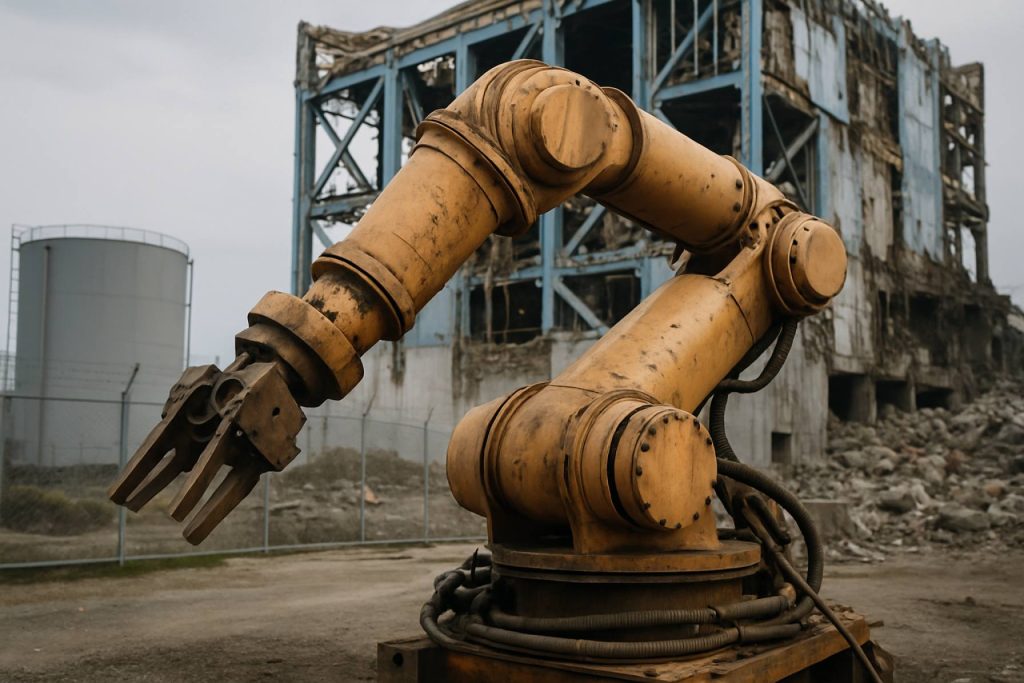
- Japan is deploying a massive, custom-built robotic arm to safely retrieve melted nuclear fuel from the Fukushima Daiichi nuclear plant, a complex job nearly 15 years after the 2011 disaster.
- The arm, stretching 22 meters with 18 articulated joints, must navigate extreme radioactivity and tight spaces, highlighting the cutting-edge engineering and precision required for nuclear decommissioning.
- Setbacks are frequent, with repeated delays and technical challenges, but the commitment to safe cleanup remains strong—over $50 million has been dedicated to the project.
- Engineers stress that every progress hinges on a cycle of testing, error correction, and persistence, while officials balance optimism with the need for pragmatic assessment of evolving realities.
- The Fukushima effort reflects the broader global challenge: true recovery from nuclear disasters relies on innovation, resilience, and the refusal to accept shortcuts.
Behind the fortress-like security of the Fukushima Daiichi nuclear power plant, a monumental experiment in engineering and resilience pushes forward—sometimes inch by painstaking inch. Deep beneath Reactor No. 5, a low, dimly lit space echoes with the hush of possibility and the clatter of daunting obstacles. Here, engineers prepare a machine like no other: a robotic arm, 22 meters in length, weighing over four tons, built to delve into the radioactive unknown and recover the dangerous debris left behind by a disaster that changed Japan forever.
Resembling the reach of a mechanical giraffe, this arm is not a gleaming sci-fi vision but a marvel born of necessity—eighteen joints articulating with the precision of a surgeon, designed to slip through openings barely wide enough to admit a slender child. Its mission: to safely extract samples of melted nuclear fuel from Reactor No. 2, where nearly a decade and a half after the tsunami, more than 880 tons of radioactive debris remain entombed—a chilling reminder of 2011’s catastrophe.
The stakes could scarcely be higher. Japan has committed vast resources to the decommissioning effort, with over $50 million invested in the development of this robot alone. The challenge isn’t just the radiation; it’s the perilous ballet the machine must perform. A single miscalculated twist or misjudged angle, and the arm would crash against steel or concrete, halting progress and raising new dangers. Every movement is tested in mockups, every setback catalogued: faulty cables, unsteady pivots, the wear of time and exposure conspiring against success.
This is the anatomy of a high-wire act—invisible to most, but vital to Japan’s hopes of reclaiming its scarred coastline. New problems erupt with the regularity of high tide. A failed obstacle-removal mechanism here, a deteriorated electrical cable there, and another round of careful post-mortem and engineering tweaks begins. Yet, each adjustment brings them closer to a trial that could define the project’s legacy.
Despite progress, uncertainty stalks every engineer and executive involved. The robotic arm’s debut has been postponed four times. Already, engineers have had to twice rely on a simpler, proven device to conduct initial retrieval tests. If final operational tests fail, the once-promising behemoth threatens to become an artifact of lost hopes, stored away as a costly testament to audacity and improvisation.
Even as officials sound notes of optimism, a current of anxiety flows beneath the surface. Some urge a pragmatic review, warning against clinging to plans that no longer fit the evolving reality. Yet the underlying commitment remains unshakeable: Japan cannot leave Fukushima in limbo, nor can it afford shortcuts. Only through a slow, relentless process—test, fix, repeat—can the country ever reach the day when Fukushima’s name no longer conjures dread.
The ultimate takeaway for a world watching with bated breath: innovation is not a straight line. The most ambitious solutions to our greatest crises emerge not from perfection, but from unyielding persistence in the face of setbacks. Whether this robotic arm succeeds or stands silent as metal sculpture, it already embodies the determination driving Japan’s hard-won recovery.
For more context on Fukushima and nuclear decommissioning, visit TEPCO and Mitsubishi Heavy Industries.
Ingenious Machines vs. Immense Danger: Fukushima’s Robot Arm and the Epic Battle for Nuclear Clean-Up
Introduction: A Second Life for Fukushima?
Years after the 2011 disaster, the world’s eyes remain fixed on the Fukushima Daiichi nuclear power plant. While much has been said about Japan’s engineering marvels and persistent recovery efforts, deeper insights reveal a story of high-tech hope, resourceful setbacks, intense scrutiny, and lessons for the entire energy sector.
Here’s a closer look at facts and forecasts—the realities, innovations, risks, and what’s next for Fukushima’s mission-critical robotic arm.
—
Additional Facts Not Fully Explored in the Source
The Scale of Radioactive Debris
– Debris Distribution: Over 880 tons of melted nuclear fuel (“corium”) are estimated spread among reactors 1, 2, and 3. The majority is believed to be in reactor 2, but precise mapping remains incomplete due to high radiation (World Nuclear Association, 2024).
– High-Radiation Barriers: Some reactor interiors reach over 650 Sieverts per hour—instantly fatal to humans. Even advanced electronics require heavy shielding.
The Robotics Race: Designs & Contenders
– Multiple Robot Designs: Several robot types have been tried, including “scorpion” and snake-like crawlers from Toshiba and Hitachi. Most failed shortly after entering due to harsh conditions (TEPCO, Reuters 2023).
– Mitsubishi Heavy Industries (MHI), in partnership with the UK’s Sellafield Ltd. and International Research Institute for Nuclear Decommissioning, helped design the current 22-meter robot arm.
– Remote Operation: The robot is managed remotely from a heavily shielded control room with real-time video and haptic feedback for precise maneuvering.
How-To: Fukushima’s Debris Removal Workflow
1. Site Preparation: Engineers send miniature drones or robots first to assess obstacles & radiation.
2. Mockup Testing: Complete replicas of reactor interiors allow for weeks of practice runs.
3. Insertion: The robot arm, assembled in segments, threads through a reinforced access port.
4. Sample Collection: Custom grippers pick up debris; sensors track force and radiation.
5. Remote Extraction: Collected samples are sealed in shielded containers, then transported to temporary storage.
Real-World Use Cases
– Global Applications: Lessons from Fukushima guide UK’s Sellafield nuclear clean-up; similar robots are being developed for Chernobyl’s aging sarcophagus (BBC, IAEA).
– Disaster Response: The approach also influences robotic aid in chemical spills and bomb disposal.
Market Forecasts & Industry Trends
– Robotics in Nuclear Decommissioning: Projected to reach $3.7 billion globally by 2030 (Grand View Research), with heightened demand in the U.S., Europe, and Asia-Pacific for next-gen, radiation-hardened AI robots.
– Japanese Technology Export: Success at Fukushima could drive exports of Japan’s nuclear robotics expertise, boosting the sector’s global standing.
Features, Specs & Pricing
– Length: 22 meters (approximately 72 feet)
– Weight: 4+ tons
– Degrees of Freedom: 18 articulating joints for highly flexible maneuvering
– Cost: Over $50 million for a single prototype (TEPCO, 2024)
– Materials: Special alloys and ceramics for heat and radiation resistance
– Control System: Remote joysticks, video, and force feedback
Pros & Cons Overview
Pros:
– Enables debris retrieval without human exposure to lethal radiation.
– Precision engineering reduces risk to reactor structures.
– Each recovered sample provides vital data for future work.
Cons:
– Highly complex—risk of mechanical or control system failure remains high.
– Unpredictable reactor interiors could stymie robots, causing costly delays or damage.
– Requires ongoing, expensive maintenance and upgrades.
Controversies & Limitations
– Delays Spark Criticism: Each postponement fuels local and global skepticism about TEPCO’s decommissioning timeline.
– Budget Overruns: Rising costs pressure government and industry partners.
– Transparency Issues: Citizens and critics demand more frequent progress updates.
Security & Sustainability
– Cybersecurity: Remote operation relies on highly secure digital links to prevent hacking (Japan’s NISC oversight).
– Radioactive Waste Storage: Recovered debris must be safely managed, sparking debate over long-term storage methods.
– Environmental Impact: Robotic extraction minimizes groundwater contamination risk compared to alternative demolition.
Reviews & Comparisons
– Compared to Chernobyl: Chernobyl’s “lava” debris was mostly entombed; Fukushima aims for active extraction and safer dismantling. This marks a world first.
– Alternative Technologies: Drones, legged robots, and wheeled probes have all failed in Fukushima due to tight spaces and radiation-induced malfunctions.
Insights & Predictions
– First Sample Milestone: Success retrieving even a single fuel fragment will be an historic achievement, validating years of international research and design.
– Future Automation: AI-driven robots with real-time adaptive control could accelerate future retrieval tasks.
– Global Benchmark: If Japan’s method succeeds, it will become a blueprint for aging nuclear plants worldwide.
—
Pressing Questions Readers Ask—Answered
1. Why is melted fuel removal so slow?
– Extreme radiation, unstable debris, and severe corrosion make every step hazardous and unpredictable. Working robotically reduces risk but is painstakingly slow.
2. What happens if the robot fails?
– Engineers revert to simpler, proven retrieval methods, likely further delaying cleanup and ballooning costs.
3. How long until Fukushima is “safe”?
– Official forecasts say 30-40 years for full decommissioning—assuming no major setbacks.
4. What is Japan doing with removed debris?
– Samples are safely stored in high-security, shielded facilities on site. Final disposal solutions are still debated.
5. How is public safety ensured?
– All operations occur inside shielded buildings, with air and water regularly monitored for radioactive leaks (TEPCO public reports).
—
Actionable Recommendations & Quick Tips
– Stay Informed: For updates, follow Japan’s official project sites TEPCO and Mitsubishi Heavy Industries.
– Support STEM and Robotics: Encourage youth and local institutions to participate in robotics competitions and nuclear safety studies—these skills are vital for global emergencies.
– Demand Transparency: If you’re in an affected region or have a stake in nuclear policy, advocate for timely updates and independent reviews of decommissioning progress.
– Invest in Clean-Tech Funds: Investors can look at robotics, engineering, and nuclear safety funds riding these long-term trends.
—
Final Takeaway
Fukushima’s robotic arm is more than a marvel of engineering—it’s a symbol of dogged perseverance and a case study for nuclear safety worldwide. As setbacks mount and questions arise, the overarching lesson remains: success in complex, high-stakes recovery hinges on relentless problem-solving, international collaboration, and transparent progress.
_Stay tuned for updates—what succeeds (or fails) at Fukushima will determine how humanity confronts future atomic crises._



